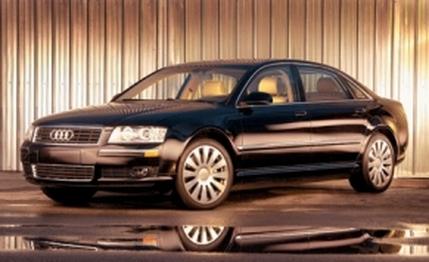 Road Test
Road Test

Do you feel a trifle heavy? Do you quiver in the presence of large magnets? Are your electrons leaving you when it rains? Perhaps what you need is more aluminum.
The Audi A8 has been reducing the planet's ferrous consumption since the model was introduced in Europe in 1994 as the world's first all-Coke-can car to hit volume production. Asked what vehicles they personally found interesting that year, car engineers were at least as likely to answer the A8 as the Superior Crown Sovereign (it's a hearse, also featured prominently in our July 1994 issue).
Sure, the A8's lightweight skeleton of aluminum extrusions, stampings, and castings crawled out of an engineer's steamy dreams, but the $67,480 base price of the first car we tested in January 1997 came from a dealer's polyester nightmare. The A8 was almost twice the price of the A6 and about $12,350 base to base more than a Lexus LS400, which we favored over the A8 in a November 1999 comparison.
Worse, the A8's styling was about as electrifying as a 1040 long form and didn't really play up the aluminum angle. It didn't play up the four-wheel-drive Quattro capabilities, either. Or the fabulous handling. Or the fact that the A8 was a car and not a Sub-Zero freezer tipped on its side. At least not to potential buyers who walked away in herds. The old A8's biggest year in the U.S. was 1999. Dealers sold 2481 cars, or 0.01 percent of '99 new-vehicle sales.
Alas, the new A8 looks more like a car and less like a restaurant appliance. Audi's stylists have pulled up the beltline and rounded off the roof. They've stretched the wheelbase by 2.6 inches to create the L (the only version sold in the U.S.) and shortened the front and rear overhangs. They have stuffed the fenders with more rubber and cast aluminum.
In short, they've endowed the A8 with some of the styling tension of Audi's other models. So much so that a quick glance can leave uncertainty about which Audi is being eyed.
Inside, the bland dash and the puffy Care Bear steering wheel have vamoosed. A compact four-spoke rim does the course control now while the speedo and tach look out through what appear to be the exhaust stacks of a tractor-trailer. Although airy and comfortable, the whole burl-laminated cockpit seems to snuggle in closer with lower seats and a higher center console that ramps upward to meet the dash. The back seat, meanwhile, has enough legroom for a passenger shaped like Shaq, although it lacks the rear-seat adjustments found on some Mercedes S-class and BMW 7-series models.
The A8 continues the Volkswagen/Audi march toward perfect interior execution. Search every surface with your fingers; you won't find a single jagged mold partline, a gap that is thicker than a fingernail, or a trim piece that doesn't feel solidly planted, as if it had been milled right out of the background material. The switches glide to their positions on films of lubricant, the buttons click down with bolt-action precision, the knobs feel as if they were turning pocket-watch cogs. Even the rear coat hooks swing down from the roof on damped hinges.
The centerpiece of this ergonomic opus is the knurled knob that controls the dashboard's hidden seven-inch LCD screen. At the tap of a button it pops out like a jack-in-the-box to serve up navigation, radio, and car-system information like BMW's iDrive superknob.
For people accustomed to driving regular old cars, Audi's approach with its Multi Media Interface, or MMI, is a little more intuitive, a little easier on the cranial processor than BMW's. The Audi's various subject menus, such as navigation, telephone, and radio, are accessed by large, dedicated buttons around the control knob rather than by swishing the knob around, as with the BMW.
A roving thumb and forefinger quickly memorize the layout of the Audi's buttons. Better still, many of the most important functions still have their own buttons, including the radio seek (thumb wheels on the steering-wheel spokes allow you to change volume and roam among the presets), the electronic stability control, and the climate control. The latter retains a dedicated panel on the console that looks and behaves like a conventional automatic climate system.